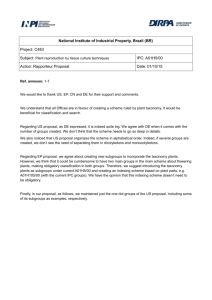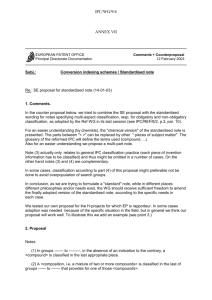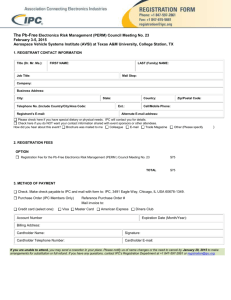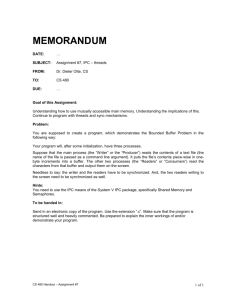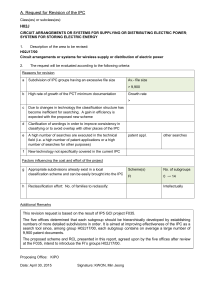Classification practice
advertisement
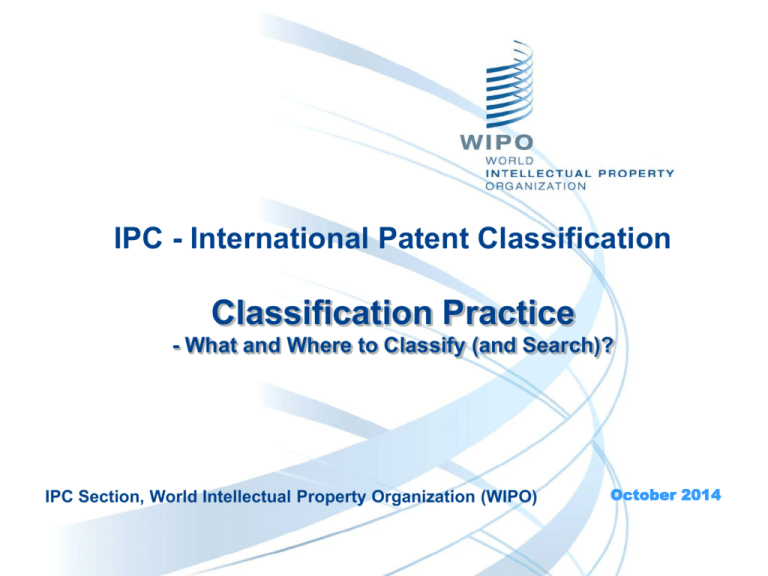
IPC - International Patent Classification Classification Practice - What and Where to Classify (and Search)? IPC Section, World Intellectual Property Organization (WIPO) October 2014 Where? Selecting appropriate places is similar for Classifying patent applications / granted patents; Searching state of the art for examination. 2 What is classified? Two types of technical information worth classifying: Invention information Technical information worth granting a patent obligatory classification Additional information Supplementary non-invention information the classifier/examiner considers important discretionary classification 3 Invention Information Technical information that represents an addition to the state of the art All novel and unobvious subject matter specifically disclosed in a patent document Claims as guidance, but also in description In examined patent only in claims Each piece of invention information classified separately At least one symbol given as Invention Information even if no invention obligatory classification 4 Invention Information Technical subject with which an invention is essentially concerned should be classified as a whole – not by separate classification of constituent parts unless constituent parts are novel and unobvious. When classifying a large system as a whole, parts or details should also be classified if inventive. Example: a leaf spring into a vehicle wheel suspension - classified in the place for this system (B60G vehicle suspension arrangements), and if the leaf spring as such is novel and unobvious, also classified in the place for the thing itself (F16F springs) 5 Additional information Non-trivial technical information which does not represent an addition to the state of the art but might constitute useful information for search. Complementing invention information, e.g. elements or components of a process or structure; constituents of a composition or mixture; use or applications of classified technical subjects if non-inventive. Allows search by combination of symbols. non-obligatory classification 6 Invention and Additional Information Example: Metal rod wine rack (Training Example:M5) Invention Information A wine rack which is easily dismantled Additional Information A rigid wine rack made of “wire” Int. Cl. A47B 73/00 (2006.01) Bottle cupboards; Bottle racks A47B 47/02 (2006.01) Racks characterised by features related to dismountability A47B 55/02 (2006.01) Racks having essential features of rigid construction (made of wire) 7 1st step of classifying (search) Determine the subject matter to be classified (searched). Basic categories of subject matter: Processes, products, apparatus or material Things “per se” and adaptations 8 Categories of Technical subjects Categories used in IPC: Processes: e.g. preparation of foodstuffs, testing, methods of operating machines, processing of information, separation, etc. Products: e.g. chemical compounds, compositions, fabrics, articles of manufacture, etc. Apparatus: e.g. tools, machines, devices, etc. Material: ingredients of mixtures, etc. Methods: of using a product or performing an operation Each category should be separately classified if needed. 9 Categories of Technical subjects For example, if a product is inventive and its method of manufacture is inventive, then both the product and its method of manufacture should be classified. In addition, if a particular use is disclosed, then the use should also be classified. Numbers of classification do not always correspond to independent claim. 10 Categories not explicitly provided for in classification titles If for one of the categories, no distinct place has been identified by the titles of the IPC, the most appropriate place existing for the other categories is used for classifying: Chemical compounds, and a specific field of use; Chemical mixtures or compositions, or its use or application; Preparation or treatment of compounds, or the Compound; Apparatus or Processes. Definitions, notes, references may provide specific information. See § 92-100 of the Guide to the IPC. 11 Function and application-oriented places IPC discriminates between two fundamental categories of technical subjects: • Things “per se”, “in general”, i.e. characterised by their intrinsic nature or function, i.e. independent of its field of use; ► Function-oriented place • Things specially adapted for particular use or purpose. ► Application-oriented place 12 Function and application: examples Function-oriented Places - C07: Organic compounds characterised by structure only - F16K (Valves), B01D (Filters), F16F (Springs) Application Places - C05 covers use of organic compounds as fertilisers - A61F 2/24 covers mechanical valves specially adapted for insertion into a human heart - A47J 31/06 covers filters for coffee or tea makers - B60G 11/00 covers incorporation of a spring into the suspension of a vehicle “specially adapted for” in the title 13 What and Where ? N.B. One document may contain several different technical subject matters (inventive things) to be classified (e.g. independent claims). All inventive things have to be classified, several classifications must be assigned if needed! 14 Example Patent documents IPC symbols Claim 1 - Claim 2 (dependent claim) - Claim 3 (dependent claim) G67K 1/00 (invention information) • Claim 4 - Claim 5 (dependent claim) F88Z 1/00 (invention information) B91M 1/00 (additional information) 15 Where? Traditional principle: As few symbols as possible, as much as necessary! > Idealy one symbol (historically important reason: limit paper search file) Complementary principle: Classify everything interesting for search purposes! (efficient retrieval of documents) 16 Types of IPC symbols Classification symbols normally stand for concepts (longer titles), i.e. a combination of characteristics/features. Indexing codes only describe one additional characteristic of the subject matter to be classified i.e. adding an indexing symbols is like adding a keyword (indexing). 17 Indexing Codes Used only in specific areas to classify additional information of interest for search Discretionary classification i.e. indexing codes are never given alone, they always supplement one or several ordinary symbols. Never presented first Only specific places are used for indexing codes: Indexing subclasses (B29K, B29L, C10N, C12R, F21W, F21Y) Indexing main groups (e.g. A01D 101/00, C04B 103/00,..) 18 Example of Indexing subclasses: F21W 19 Example of Indexing scheme: C04B 103/00 20 Types of IPC Symbols Summary Invention information: Classification symbols Additional information: Classification symbols Indexing codes 21 Classification Rules Different classification rules may apply: First place priority rule Last place priority rule B32B Note(s) 5. In groups B32B 1/00-B32B 33/00, the first place priority rule is applied, i.e. at each hierarchical level, in the absence of an indication to the contrary, classification is made in the first appropriate place. Note(s) In this subclass / main group(s) / group(s), the last place priority rule is applied, i.e. at each hierarchical level, in the absence of an indication to the contrary, classification is made in the last appropriate place. give priority between groups of the same hierarchical level avoid multiple classification in case of overlap Special rules (see§155 of the Guide) Multiple classification (C04B 38/00) Subject-specific rules (C08L) Common rule (default, if no other rules specified) 22 Common Rule Common Rule aims at limiting multiple classification when many symbols should be allotted. Priority for groups for more complex subject matter groups for more specialised subject matter However, classification in several places if priority not given, only places for subcombinations place of lower priority is useful for search 23 Question Example: Inventive subject matter A (1/00) is characterized by subcombinations of B (1/04) and C (1/08) in the following scheme which has no provision for combinations: 1/00 1/02 1/04 1/06 1/08 main group A . subgroup . subgroup B . subgroup . subgroup C Question: Classification(s) under CR/FPPR/LPPR? Answer: if Common Rule > B and C if First Place Priority Rule > B if Last Place Priority Rule > C 24 Question Q. In main group A21D 2/00, where would you classify treatment of dough by adding a mixture of ascorbic acid and seed germs? (In view of the last place priority rule in group A21D 2/00.) 25 A21D 2/00 Treatment of flour or dough by adding materials thereto before or during baking (A21D10/00 takes precedence) Note(s) In groups A21D 2/02-A21D 2/40, the last place priority rule is applied, i.e. at each hierarchical level, in the absence of an indication to the contrary, a substance is classified in the last appropriate place. A21D 2/02 · by adding inorganic substances A21D 2/04 · · Oxygen; Oxygen-generating compounds, e.g. ozone, peroxides A21D 2/06 · · Reducing agents A21D 2/08 · by adding organic substances A21D 2/10 · · Hydrocarbons A21D 2/12 · · Halohydrocarbons A21D 2/14 · · Organic oxygen compounds A21D 2/16 · · · Fatty acid esters A21D 2/18 · · · Carbohydrates A21D 2/20 · · · Peroxides A21D 2/22 · · · Ascorbic acid A21D 2/24 · · Organic nitrogen compounds A21D 2/26 · · · Proteins A21D 2/28 · · Organic sulfur compounds A21D 2/30 · · Organic phosphorus compounds A21D 2/32 · · · Phosphatides A21D 2/34 · · Animal material A21D 2/36 · · Vegetable material A21D 2/38 · · · Seed germs; Germinated cereals; Extracts thereof A21D 2/40 · Apparatus for the chemical treatment of flour or dough 26 Selecting / Finding IPC place Different approaches/strategies: Browsing the IPC scheme Catchword Index Terms (text search of the IPC) IPCCAT (automated classification tool) STATS (statistical approach using PATENTSCOPE) 27 Browsing the IPC scheme Simple approach: Section Browsing the IPC Unspecific titles Class Subclass Main Group Specific titles Subgroups 28 Catchword Index 29 Catchword Index 30 Terms (text search in the IPC) 31 IPCCAT (categorization tool) A categorization assistance tool for the IPC designed to help to classify patent documents at IPC subclass/main group level Designed with the concept of full phrases describing the technical subject matter (not a keyword search tool) Upload of document is possible Based on artificial neural network It is suggested that patent abstracts be used (at the minimum), and not a random selection of text from the patent description. Need to consult the IPC scheme Available at: https://www3.wipo.int/ipccat/ 32 IPCCAT 33 IPCCAT 34 IPCCAT 35 STATS (Statistical approach) Identifies IPC entries most frequently referenced in the PATENTSCOPE database searched by particular terms. Statistical presentation of the search results is performed according to IPC subclasses and groups. Search by simple terms and multi-term (combination of simple terms separated by a space) in all patent collections of the PATENTSCOPE. 36 STATS 37 STATS 38 STATS 39 STATS 40
